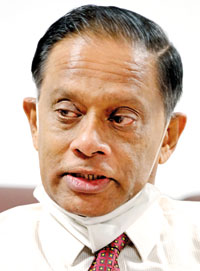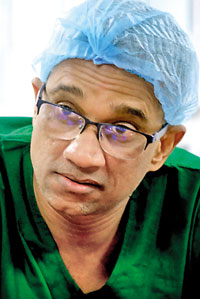News
Smiles all round after mother & daughter mark medical first

Mother and daughter: Bonded forever with a shared liver are Rasika and Kishanu . Pix by Amila Gamage
Her tender life was in their hands and it was “touch-and-go” at a crucial point not only during the marathon trailblazing surgery but also on Day 0 soon after the operation.
On Wednesday (July 22) though when the Sunday Times meets some of the team members for a three-hour wide-ranging interview, they are relaxed and smiling, joking how their first proper meal after the 15-hour marathon was bread, parippu (dhal) and seeni sambol, while the little one, when allowed food firstly savoured a chocolate biscuit.
………And in another section, wide are the smiles of a mother who hugs her daughter whose bed in the ICU is festooned with balloons with a large teddy bear at her feet, while far away in the northern peninsula, the other members of this humble family – a father and son – are overjoyed.
The first successful liver transplant for a child and that too from a living donor has been performed in Sri Lanka on July 14 at the Colombo North Teaching Hospital (CNTH), Ragama, without much fanfare but overcoming many a challenge.
The child-recipient is S. Kishanu and it is her own mother S. Rasika (38) who donated part of her liver to pull her back from the jaws of death.
As the CNTH Organ Transplant Team looks ahead at ensuring a sustainable transplant programme for adults and children, it is a double celebration in their journey – the successful paediatric liver transplant is a major milestone, as coincidentally they mark their 50th transplant.

Dr. Zainab Razeen, acting as our translator, during the interview with Rasika
The pathway to both cadaveric and living-donor transplants had been charted by visionaries such as Prof. Janaka de Silva, Prof. Kemal Deen and Prof. Ranil Fernando of the Faculty of Medicine, University of Kelaniya, back in the late 1990s. Strewn with ups and downs, the programme had finally got on course in 2011.
The July 14 paediatric liver transplant has been ‘unique’ in more ways than one – for wide and varied have been the unstinting support the transplant team got from their hospital under the leadership of Director Dr. Shelton Perera; other hospitals and donors. Surgical instruments and anaesthetic equipment had been collected from within the hospital and borrowed from without.
The team refers with much appreciation to Hemas Hospital, Wattala, the management of which without any hesitation acceded to a request to give one of their precious ICU beds for eight long days, without charging a cent and seeking “nothing” in return.
Then there were also three doctors, seeing the plight of this family from Jaffna, with no kith and kin network at Ragama, who used their good offices to collect Rs. 600,000 for them to rent a small place close to the hospital and also for the “unseen” costs of their travel, food, clothes, medicines and some laboratory tests that needed to be done from outside.

Prof. Rohan Siriwardana
For the children and parents of Sri Lanka, no news can be better. Before the red-letter day of July 14, if a child was diagnosed with end-stage liver disease, the only option was for the parents to go around with a begging bowl and sell whatever of value they had to collect the huge sum of money needed to take the child abroad or heartrendingly watch the child die.

Dr. Meranthi Fernando
The tale of this paediatric liver transplant begins when Kishanu “on a chance” was referred to Consultant Hepato-Pancreato-Biliary Surgeon Prof. Rohan Siriwardana, two months ago by the Jaffna Teaching Hospital (JTH). Late last year, the family had gone to JTH as Kishanu was not gaining weight. A battery of tests found that she had a serious issue with her liver.
Dr. V. Thusyanthan and Dr. K. Arulmoli of the JTH who had trained at the CNTH and were aware of the adult liver transplant programme had approached their Director and suggested that Kishanu be sent to the CNTH.
When faced by the hopelessness of the family, Prof. Siriwardana had sought an assessment from Consultant Paediatrician Dr. Meranthi Fernando.

Dr. Suchintha Tillakaratne
“I assessed Kishanu’s liver condition – whether she could undergo a transplant; whether there were any contraindications and complications against such a transplant and whether the child was stable for such major surgery,” says Dr. Fernando.
The cause of her chronic liver disease was probably due to metabolic liver disease. In many cases, the cause may never be determined, it is understood, and the team is awaiting test results to see whether there is a genetic factor involved.
What was heartbreakingly clear to Dr. Fernando was that the child was critically ill, showing signs of progressive deterioration. Her abdomen was distended due to fluid collection and the yellowing of her eyes had deepened. She had lost her appetite and there was nutritional deficiency. The vital functions of the liver which included albumin synthesis and blood-clotting regulation were hindered.

Prof. Ranil Fernando
“There was no doubt that Kishanu was dying,” she says and the only option was a transplant.
The decision was then made by Prof. Siriwardana to go ahead with the transplant and the team got activated. Even though they had not done a paediatric transplant before – it was a first for them – they had skill and experience in adult living donor transplants. They also had on board Dr. Meranthi Fernando who had a special interest and training in liver disease and liver transplantation in children and had just returned from the United Kingdom and Consultant Hepato-Pancreato-Biliary Surgeon Dr. Suchintha Tillakaratne who had trained in both paediatric and adult transplantation.

Dr. Bhaagya Gunetilleke
They told Kishanu’s parents the truth – that the team had not attempted such a transplant before and that the child could die despite their best efforts. The parents were willing to take the risk because the child was going to die anyway without a transplant.
Would it be a liver from a cadaver or a living donor? Kishanu’s mother was healthy and seemed to fit the bill as a donor and she was more than happy to donate part of her liver to her beloved daughter.
The blood groups and liver size matched but to be on the safe side in case something went wrong, the team looked for a “back-up” and found another matching liver in Kishanu’s aunt (mother’s sister), V. Sumithra (40).
Permission was also sought and granted by the Director-General of Health Services, Dr. Anil Jasinghe to go ahead.

Kishanu’s first bite of a chocolate biscuit after the surgery
It was like a military-style operation…..going through scenarios of before-and-after transplant and fine-tuning the details.
“We rehearsed for two days before the transplant, going into meticulous detail of where each instrument and monitoring machine would be kept, how the lights would be and where each person on the team would be positioned,” smiles Prof. Siriwardana, explaining that they photographed everything as well.
Consultant Anaesthetist Dr. Bhaagya Gunetilleke points out that as the biggest danger to a transplant patient comes from infection, the operating theatres were swabbed and all the instruments sterilized thoroughly.
“The post-operative period is crucial and we don’t have a dedicated ICU for transplant patients. Possible infection in the six-bed ICU at the hospital could cause deadly consequences. This is why we sought the assistance of Hemas Hospital,” he adds.
We see Kishanu on Wednesday (July 22) back at CNTH – her beautiful smile, the gift for all those involved in this pioneering transplantation.

Kishanu in the CNTH ICU
| A glimpse of the marathon surgery Tuesday, July 14: All were set by 5 a.m. for the first successful paediatric liver transplant in Sri Lanka at the Colombo North Teaching Hospital (CNTH). Side-by-side were the two operating theatres (OT), the donor-mother in one and the recipient-daughter in the other. Wielding the scalpel over the donor was Prof. Rohan Siriwardana, opening up Rasika under general anaesthesia (GA), through a reversed L-shaped cut on the abdomen for the retrieval of a part of her liver in an operation lasting six hours. “We took the left lobe of the two-lobe liver by splitting it, then cleaned it up and placed it in a special preservation solution [Histidine-tryptophan-ketoglutarate (HTK) solution – a high-flow, low-potassium solution] in a tray in an ice basin on a trolley. This was about 325gm and 40% of her total liver volume,” says Prof. Siriwardana, explaining that the liver is an amazing organ which has the ability of regeneration. Pointing out that this is why a part of the liver can be taken safely from a living donor, he reiterates, however, that it is “complex surgery” because “we are operating on a ‘healthy person’ who is taking a significant risk to save someone else’s life. We must make sure that the living donor comes to no harm”. Kishanu who was also under GA had undergone an inverted T-shaped cut on her abdomen under the hands of Dr. Suchintha Tillakaratne, who cleared her diseased liver from adjoining structures. As soon as the donor liver was brought in, they dissected her diseased liver from the blood vessels and the bile duct, implanting the donor liver and stitching the blood vessels back. Recalls Prof. Siriwardana how the child’s blood vessels were so fine that he had to use thin hair-like sutures under magnification to link them to the brand new liver and then remove the clamps to allow the blood to flow through. The anaesthetic team was keeping a close eye on Kishanu’s vital parameters including her heart rate, blood pressure and breathing and also a tab on the depths of anaesthesia to make sure that the child remained unconscious (not too deep) but free of pain. The nail-biting moment arose at the time of re-perfusion (restoration of the blood circulation) of the liver, when there was a dip in Kishanu’s condition. “There is no time for emotion – war mode,” is how the team describes their response, with the nurses giving the instruments no sooner the surgeon’s hand was stretched out. Stabilization of her condition followed and then the final anastomosis (connection) with the bile duct. The transplant over, Kishanu was then eased out of anaesthesia. She had been wide awake when she was taken by ambulance to the Hemas Hospital ICU. The marathon 15-hour transplantation from 5 a.m. to 8 p.m. had ended successfully. But Kishanu was not out of the woods yet. In the ICU on Day 0, was worry-time for Dr. Meranthi Fernando once again over her vital parameters. By Day 2, however, they steadied and smoothened out by Day 3. The child would be on immuno-suppressants life-long, a small price to pay for not forfeiting her life to end-stage liver disease. The surgical team headed by Prof. Rohan Siriwardana comprised Dr. Suchintha Tillakaratne; Dr. Aruna Weerasooriya; Dr. Ruwan Dissanayake & Dr. Prabath Kumarasinghe (from the NHSL); Dr. Buddhika Dassanayake (from the Peradeniya Teaching Hospital); Dr. Buddhika Uragoda; Dr. Chanaka Ekanayake; & Medical Officers (MOs), ably assisted by the nursing team led by Nursing Officers L.N. Damayanthi & P.A.M. Perera. The anaesthetic team headed by Dr. Bhaagya Gunetilleke comprised Dr. Chamila Liyanage; Dr. Dakshi Jayawickrama; Dr. Nilmini Wijesuriya; Dr. Oliver Pathmaperuma (from the Chilaw Hospital); Dr. Nilmini Manawaduge; Dr. Nadeeshya Welikala; Dr. Vishaka Kerner, Dr. Shehan Wijesiriwardana; & MOs. The paediatric hepatology team headed by Dr. Meranthi Fernando comprised Dr. Asanka Rathnasiri; Dr. Thabitha Hoole; Dr. Arunath Visvalingam; Dr. Oshini Muthukumarana; Dr. Ishara Kumarasiri; Dr. Heshala Nawagamuwa & Dr. Renu Kalansooriya; supported by nursing and support staff led by Sr. Wasana Palpagama. The radiology team comprised Dr. Chinthaka Appuhamy & Dr. Eranga Ganewatte. While the theatre nursing team included Nursing Officers D.P.B.S. Sandamali; H.A.G. Dilrukshi; A.M.N.N.K. Wickramasinghe; & E.M.M. Ethugala; the fund-raisers for the family were Dr. Thabitha Hoole, Dr. Arunath Visvalingam & Dr. Paul Bright.
| |
| Humble family from Jaffna, the beneficiaries They were just like millions of families living below the poverty-line scattered across Sri Lanka. The sole bread winner was N. Sarangan (39), a mason who worked about 20 days a month, earning about Rs. 1,500 as his daily wage. Sometimes alcohol was his companion which would cause a dent into their family budget. Living in Mulai about 15km from Jaffna town, S. Rasika was the home-maker seeing to the chores and needs of their son S. Suvarian (14) and S. Kishanu (9). School was a short walk from home and Kishanu loved chithra (art) and even put colour pencils to paper during recovery, says Rasika who has just been discharged when we meet her, with Paediatric Registrar Dr. Zainab Razeen, acting as our translator. The initial troubles had come when Kishanu was diagnosed with a hole in her heart which was closed in 2015 at the Lady Ridgeway Hospital (LRH) for Children, Colombo, with funds from the President’s Fund. In October 2019, came the next hit. This time it was her eeral (liver). Now that is recent history and mother and daughter give bright smiles for the camera. |

